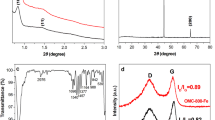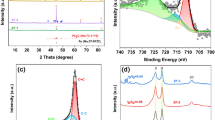Abstract
Designing high-performance microwave absorption (MA) materials becomes a considerable urgent demand with the rapid development of informatization in the modern world. Petroleum asphalt (PA)/Fe3O4 as absorbents with interconnected porous carbon nanosheets has been successfully fabricated by pyrolyzation and solvothermal approaches. The addition of NaCl as templates directly results in the formation of porous nanosheets structures, which improves the dielectric loss and facilitates the polarization effect of PA/Fe3O4 composites. Dramatically, a minimum reflection loss (RLmin) of PA/Fe3O4/paraffin (filler content is only 20 wt.%) can reach to − 68.54 dB (99.999986% wave absorption) and the effective absorption bandwidth covers up to 5.12 GHz with a thickness of 1.8 mm when the mass ratio of PA to Fe3O4 is 1:1. This study suggests that our work may open a new direction for designing candidate MA materials and can be able to achieve the use of PA-based materials with the advantages of low cost, high yield and environment-friendly according to the huge commercial value of PA itself.
Graphical Abstract










Similar content being viewed by others
Data and code availability
All the data and code collected from the cited references can be easily accessed according to a DOI to an electronic repository. The data from this study are available from the corresponding author upon reasonable request.
References
Yan K, Wu C, Xie L, Ji G, Zeng L, Jiang Y, Jiang Z, Chang G, Xue B, Zheng Q (2023) High EMI shielding effectiveness and superhydrophobic properties based on step-wise asymmetric structure constructed by one-step method. Nano Res. https://doi.org/10.1007/s12274-023-5713-z
Lu X, Li X, Wang Y, Hu W, Zhu W, Zhu D, Qing Y (2022) Construction of ZnIn2S4 nanosheets/3D carbon heterostructure with Schottky contact for enhancing electromagnetic wave absorption performance. Chem Eng J 431(2):134078. https://doi.org/10.1016/j.cej.2021.134078
Devi N, Ray S (2022) Electromagnetic interference cognizance and potential of advanced polymer composites toward electromagnetic interference shielding: a review. Polym Eng Sci 62(3):591–621. https://doi.org/10.1002/pen.25876
Ejaz A, Shahid H, Amin Y (2022) A robust, compact and efficient AMC-enabled dual-band antenna for wearable healthcare. J Circuit Syst Comp 32(2):2350023. https://doi.org/10.1016/j.compscitech.2019.02.031
Liu W, Duan P, Ding Y, Zhang B, Su H, Zhang X, Wang J, Zou Z (2022) One-dimensional MOF-derived magnetic composites for efficient microwave absorption at ultralow thickness through controllable hydrogen reduction. Dalton Trans 51(17):6597–6606. https://doi.org/10.1039/D2DT00113F
Peymanfar R, Mirkhan A (2022) Biomass-derived materials: promising, affordable, capable, simple, and lightweight microwave absorbing structures. Chem Eng J 446(1):136903. https://doi.org/10.1016/j.cej.2022.136903
Yao L, Yang W, Zhou S, Mei H, Cheng L, Zhang L (2022) Design paradigm for strong-lightweight perfect microwave absorbers: the case of 3D printed gyroid shellular SiOC-based metamaterials. Carbon 196:961–971. https://doi.org/10.1016/j.carbon.2022.06.004
Wang S, Gong H, Ashfaq M, Qi D, Xu P, Yue X (2022) Tailoring microwave absorption bandwidth of SiCN based composite ceramic fbers by tuning the embedding ratio of Ni3Si. Ceram Int 48(18):26116–26128. https://doi.org/10.1016/j.ceramint.2022.05.294
Qiu Z, Shi Z, Li R, Yan H, Chen Q, Ruan L (2022) Rapid one-pot synthesis of SiO2@SiO2/Carbon@Carbon core-shell composites with efficient microwave absorption in a short time. Ceram Int 48(14):19709–19719. https://doi.org/10.1016/j.ceramint.2022.03.186
Fan B, Xing L, He Q, Zhou F, Yang X, Wu T, Tong G, Wang D, Wu W (2022) Selective synthesis and defects steering superior microwave absorption capabilities of hollow graphitic carbon nitride micro-polyhedrons. Chem Eng J 435(3):135086. https://doi.org/10.1016/j.cej.2022.135086
Gao S, Yang S, Wang H, Wang G, Yin P (2020) Excellent electromagnetic wave absorbing properties of two dimensional carbon-based nanocomposite supported by transition metal carbides Fe3C. Carbon 162:438–444. https://doi.org/10.1016/j.carbon.2020.02.031
Li J, Xu Z, Li T, Zhi D, Chen Y, Lu Q, Wang J, Liu Q, Meng F (2022) Multifunctional antimony tin oxide/reduced graphene oxide aerogels with wideband microwave absorption and low infrared emissivity. Compos. Part. B-Eng. 231:109565. https://doi.org/10.1016/j.compositesb.2021.109565
Tian K, Wu Y, Shu R, Liu Y, Huang Y, Chen Z, Cheng G (2021) Facile synthesis of rod-like nickel cobaltite decorated reduced graphene oxide composites with excellent microwave absorption performance. Mater Lett 295:129825. https://doi.org/10.1016/j.matlet.2021.129825
Wang Y, Wen Z, Long L, Li Y, Zhou W (2021) Dielectric response and microwave absorption properties of SiC whiske-coated carbon fiber. J Mater Sci Mater Electron 32(1):442–452. https://doi.org/10.1007/s10854-020-04792-8
Zhang W, Zhang X, Zhu Q, Zheng Y, Liotta L, Wu H (2021) High-efficiency and wide-bandwidth microwave absorbers based on MoS2-coated carbon fiber. J Colloid Interface Sci 586:457–468. https://doi.org/10.1016/j.jcis.2020.10.109
Yao Z, Xu S, Zhang X, Yuan J, Rong C, Xiong Z, Zhu X, Yu Y, Yu H, Kang S, Kuang F (2023) CuCo nanocube/N-doped carbon nanotube composites for microwave absorption. ACS Appl Nano Mater 6(2):1325–1338. https://doi.org/10.1021/acsanm.2c04972
Vovchenko L, Matzui L, Yakovenko O, Oliynyk V, Len T, Naumenko A, Kulikov L (2022) Microwave absorption in epoxy composites filled with MoS2 and carbon nanotubes. J Appl Phys 131(3):035103. https://doi.org/10.1063/5.0070633
Cui J, Wang X, Huang L, Zhang C, Yuan Y, Li Y (2022) Environmentally friendly bark-derived Co-Doped porous carbon composites for microwave absorption. Carbon 187:115–125. https://doi.org/10.1016/j.carbon.2021.10.077
Wu Z, Meng Z, Yao C, Deng Y, Zhang G, Wang Y (2022) Rice husk derived hierarchical porous carbon with lightweight and efficient microwave absorption. Mater Chem Phys 275:125246. https://doi.org/10.1016/j.matchemphys.2021.125246
Zhao H, Seow J, Cheng Y, Xu Z, Ji G (2020) Green synthesis of hierarchically porous carbons with tunable dielectric response for microwave absorption. Ceram Int 46(10):15447–15455. https://doi.org/10.1016/j.ceramint.2020.03.089
Song X, Jiang R, Lei Z (2022) In-situ growth of CNTs-porous carbon from asphalt with superior double-layer capacitive performance. Appl Surf Sci 583:152549. https://doi.org/10.1016/j.apsusc.2022.152549
Yang W, Li R, Hou L, Deng B, Li Y (2021) Synthesis of a petroleum asphalt-based nitrogen/sulfur doped porous carbon material and its use as the counter electrode of dye-sensitized solar cells. Carbon 171:981. https://doi.org/10.1016/j.carbon.2020.05.094
Yang W, Deng B, Hou L, Wang T, Tian J, Wang S, Li R, Yang F, Li Y (2020) Sulfur-fixation strategy toward controllable synthesis of molybdenum-based/carbon nanosheets derived from petroleum asphalt. Chem Eng J 380:122552. https://doi.org/10.1016/j.cej.2019.122552
Wang K, Ye Z, Li X, Yang J (2022) Nanoporous resorcinol-formaldehyde based carbon aerogel for lightweight and tunable microwave absorption. Mater Chem Phys 278:125718. https://doi.org/10.1016/j.jechem.2018.05.014
Zeng X, Sang Y, Xia G, Jiang G, Xie N, Zheng N, Cheng Y, Yu R (2022) 3-D hierarchical urchin-like Fe3O4/CNTs architectures enable efficient electromagnetic microwave absorption. Mater Sci Eng B 281:115721. https://doi.org/10.1016/j.mseb.2022.115721
Araichmani P, Prabu K, Kumar G, Karunakaran G, Surendhiran S, Shkir M, Ali H (2022) Synthesis of Fe3O4-decorated SiO2 nanostructure using rice husk as a source by microwave combustion for the development of a magnetically recoverable adsorbent. Ceram Int 48(7):10339–10345. https://doi.org/10.1016/j.ceramint.2022.02.001
Chen G, Xu D, Chen P, Guo X, Yu Q, Qiu H (2021) Constructing and optimizing hollow bird-nest-patterned C@Fe3O4 composites as high-performance microwave absorbers. J Magn Magn Mater 532:167990. https://doi.org/10.1016/j.jmmm.2021.167990
Ma W, Yang R, Wang T (2020) ZnO nanorod-based microflowers decorated with Fe3O4 nanoparticles for electromagnetic wave absorption. ACS Appl Nano Mater 3:8319–8327. https://doi.org/10.1021/acsanm.0c01728
Li G, Yin Z, Guo H, Wang Z, Yan G, Yang Z, Liu Y, Ji X, Wang J (2019) Metalorganic quantum dots and their graphene-like derivative porous graphitic carbon for advanced lithium-ion hybrid supercapacitor. Adv Energy Mater 9(2):1802878. https://doi.org/10.1002/aenm.201802878
Liu X, Ou Z, Geng D, Han Z, Jiang J, Liu W, Zhang Z (2010) Influence of a graphite shell on the thermal and electromagnetic characteristics of FeNi nanoparticles. Carbon 48(3):891–897. https://doi.org/10.1016/j.carbon.2009.11.011
Mishra M, Singh A, Singh B, Singh V, Dhawan S (2014) Conducting ferrofluid: a high-performance microwave shielding material. J Mater Chem A 2(32):13159–13168. https://doi.org/10.1039/C4TA01681E
Liu Q, Liu X, Feng H, Shuai H, Yu R (2016) Metal organic framework-derived Fe/carbon porous composite with low Fe content for lightweight and highly efficient electromagnetic wave absorber. Chem Eng J 314:320–327. https://doi.org/10.1016/j.cej.2016.11.089
Duan Y, Xiao Z, Yan X, Gao Z, Tang Y, Hou L, Li Q, Ning G, Li Y (2018) Enhanced electromagnetic microwave absorption property of peapod-like MnO@carbon Nanowires. ACS Appl Mater Interfaces 10(46):40078–40087. https://doi.org/10.1021/acsami.8b11395
Duan Y, Li Y, Wang D, Wang R, Wang Y, Hou L, Yan X, Li Q, Yang W, Li Y (2019) Transverse size effect on electromagnetic wave absorption performance of exfoliated thin-layered flake graphite. Carbon 153:682–690. https://doi.org/10.1016/j.carbon.2019.07.078
Zhang X, Guan P, Dong X (2010) Transform between the permeability and permittivity in the close-packed Ni nanoparticles. Appl Phys Lett 97(3):033107. https://doi.org/10.1063/1.3464975
Zhou J, He J, Wang T, Li G, Guo Y, Zhao J, Ma Y (2011) Design of mesostructured γ-Fe2O3/carbon nanocomposites for electromagnetic wave absorption applications. J Alloys Compd 509(32):8211–8214. https://doi.org/10.1016/j.jallcom.2011.05.042
Lv H, Liang X, Ji G, Zhang H, Du Y (2015) Porous three-dimensional flower-like Co/CoO and its excellent electromagnetic absorption properties. ACS Appl Mater Interfaces 7(18):9776–9783. https://doi.org/10.1021/acsami.5b01654
Wen B, Cao M, Hou Z, Song W, Zhang L, Lu M, Jin H, Fang X, Wang W, Yuan J (2013) Temperature dependent microwave attenuation behavior for carbon-nanotube/silica composites. Carbon 65:124–139. https://doi.org/10.1016/j.carbon.2013.07.110
Yang H, Yuan J, Li Y, Hou Z, Jin H, Fang X, Cao M (2013) Silicon carbide powders: temperature-dependent dielectric properties and enhanced microwave absorption at gigahertz range. Solid State Commun 163:1–6. https://doi.org/10.1016/j.ssc.2013.03.004
Mordina B, Kuma R, Tiwari R, Setua D (2017) Fe3O4 nanoparticles embedded hollow mesoporous carbon nanofibers and polydimethylsiloxane-based nanocomposites as efficient microwave absorber. J Mater Chem C 121(14):7810–7820. https://doi.org/10.1021/acs.jpcc.6b12941
Xia T, Zhang C, Oyler N, Chen X (2013) Hydrogenated TiO2 nanocrystals: a novel microwave absorbing material. Adv Mater 25(47):6905–6910. https://doi.org/10.1002/adma.201303088
Li Y, Cao M (2016) Enhanced electromagnetic properties and microwave attenuation of BiFeO3-BaFe7(MnTi)2.5O19 driven by multi-relaxation and strong ferromagnetic resonance. Mater Des 110:99–104. https://doi.org/10.1016/j.matdes.2016.07.119
Zhou W, Xiao P, Li Y (2012) Preparation and study on microwave absorbing materials of boron nitride coated pyrolytic carbon particles. Appl Surf Sci 258(22):8455–8459. https://doi.org/10.1016/j.apsusc.2012.03.107
Acknowledgements
Special thanks are due to Key Laboratory of Science and Technology on Wear and Protection of Materials, Lanzhou Institute of Chemical Physics, for measuring the performance of the materials such as TEM, SEM, XRD and BET in this study. The research was sponsored by 2022 Young Doctor Fund Project of Higher Education institutions in Gansu Province (2022QB-205), 2021 Lanzhou Science and Technology Development guiding Plan Project (2022-ZD-150) and 2022 Major Scientific Research Project of Lanzhou Resources & Environment Voc-Tech University (X2022ZD-01).
Author information
Authors and Affiliations
Contributions
WM was involved in conception, experimental design, data analyses and writing the paper. WLL contributed to data collection and project administration. SR was involved in investigation and methodology. GFY contributed to experiments and funding acquisition. TMW was involved in writing—review and editing.
Corresponding author
Ethics declarations
Conflict of interest
The authors declare that they have no conflict of interest. All authors certify that they have no affiliations with or involvement in any organization or entity with any financial or non-financial interest in the subject matter or materials discussed in this manuscript. The authors have no financial or proprietary interests in any material discussed in this article.
Ethical approval
The authors declare that they have no conflict of interest and no living organisms were harmed.
Additional information
Handling Editor: Catalin Croitoru.
Publisher's Note
Springer Nature remains neutral with regard to jurisdictional claims in published maps and institutional affiliations.
Rights and permissions
Springer Nature or its licensor (e.g. a society or other partner) holds exclusive rights to this article under a publishing agreement with the author(s) or other rightsholder(s); author self-archiving of the accepted manuscript version of this article is solely governed by the terms of such publishing agreement and applicable law.
About this article
Cite this article
Ma, W., Li, W., Ran, S. et al. A superior microwave absorption material of porous carbon nanosheet/Fe3O4 composites from petroleum asphalt as carbon source. J Mater Sci 58, 13279–13294 (2023). https://doi.org/10.1007/s10853-023-08873-x
Received:
Accepted:
Published:
Issue Date:
DOI: https://doi.org/10.1007/s10853-023-08873-x




